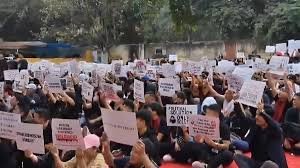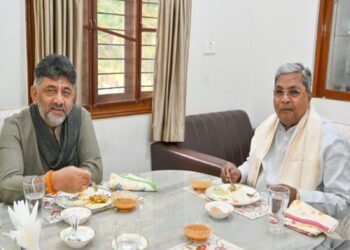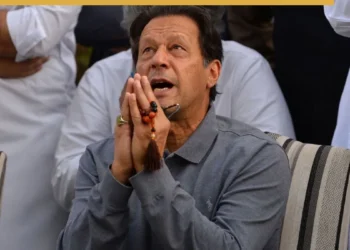By Navin Upadhyay
April 10, 2025
The recently concluded Congress Working Committee (CWC) and All India Congress Committee (AICC) session in Ahmedabad, held on April 8-9, was billed as a historic opportunity for the Indian National Congress to chart a path toward revival. However, the absence of a concrete action plan has left party workers and observers questioning the leadership’s commitment to translating rhetoric into results.
The session, themed “Nyaypath: Sankalp, Samarpan aur Sangharsh,” saw elaborate explanations from Rahul Gandhi and Mallikarjun Kharge on the party’s decline, but the lack of a strategic roadmap to address these issues has cast a shadow over the event’s potential to mark a “turning point” for the beleaguered party.
The two-day conclave, the first AICC session in Gujarat in 64 years, brought together over 1,700 delegates, including senior leaders like Congress President Mallikarjun Kharge, Sonia Gandhi, and Rahul Gandhi, at the Sabarmati Riverfront. The CWC meeting on April 8 at the Sardar Vallabhbhai Patel National Memorial set the stage for discussions on organizational restructuring, electoral strategies, and the party’s future direction. Yet, the resolutions passed during the AICC session on April 9 largely reiterated familiar talking points without offering a clear blueprint for action.
Rahul Gandhi, the Lok Sabha Leader of Opposition, highlighted a critical issue: the drift of Other Backward Classes (OBCs) away from the Congress. He called for renewed outreach to OBCs, SCs, STs, and minorities, emphasizing that these communities, which make up 90% of India’s population, have been neglected—a strategic mistake the party must correct.
ALSO READ: Analysis: Ethnic Rivalries Unravel Stability in Manipur’s Hills
Similarly, Mallikarjun Kharge struck a chord by urging leaders unable to contribute to the party’s revival to retire, signaling a need for fresh energy. While these observations were on point, they echoed the same rhetorical factors that have dominated Congress discussions for years—electoral disconnect, organizational lethargy, and failure to resonate with key voter groups—without addressing the “how” of reversing these setbacks.
CWC बैठक में गांधीगिरी… कुर्सियों के बजाय गद्दों पर नीचे बैठे नेता इस बार… pic.twitter.com/J3ugW7nwsi
— Dinesh Dangi (@dineshdangi84) December 26, 2024
The absence of a detailed action plan was glaring. Congress has repeatedly acknowledged the need to strengthen its district-level organization, a point reiterated in Ahmedabad with promises of empowering District Congress Committees (DCCs). However, no specific measures were outlined to achieve this. The party’s grassroots structure, once its backbone, remains weakened by years of neglect, and the session offered little beyond vague commitments to decentralization and accountability. Without a clear strategy to revive these units—such as targeted recruitment drives, training programs, or funding mechanisms—the promise of empowerment risks remaining hollow.
Another missed opportunity was the lack of focus on cultivating firebrand leaders who can galvanize public support. Congress has struggled to produce charismatic figures capable of countering the BJP’s aggressive messaging. While the party has a history of mass leaders like Mahatma Gandhi and Sardar Patel—whose legacies were symbolically invoked by hosting the event in Gujarat—it failed to outline a mechanism to identify and nurture such talent. A structured leadership development program, perhaps through mentorship or public speaking initiatives, could have been a starting point, but no such proposal emerged.
The session also overlooked the urgent need to entrust youthful leaders with significant responsibilities across states. Rahul Gandhi has often been projected as a young leader, but at 54, the party must look beyond him to a new generation. Figures like Gaurav Gogoi or Sachin Pilot, who have shown promise, could be given larger roles to connect with India’s youth—a demographic Congress has struggled to engage, often perceived as outdated or elitist. Yet, the leadership stopped short of announcing specific roles or state-level responsibilities for younger leaders, missing a chance to signal a generational shift.
ALSO READ: Manipur: A Month After Shah’s Mobility Pledge, Defiant Tribals Stall Any Breakthrough
Perhaps most critically, the Congress failed to launch a mass contact program, which could have been a game-changer in rebuilding its voter base. The party’s disconnect from the masses, particularly in states like Gujarat where it has been out of power since 1995, requires sustained, on-the-ground engagement. A nationwide campaign—door-to-door outreach, public rallies, or digital drives—could help Congress reconnect with voters, address their concerns, and counter the BJP’s narrative. However, the Ahmedabad session produced no such initiative, leaving party workers without a clear directive to mobilize.
The resolutions passed at the AICC session touched on socio-economic justice, electoral reforms, and critiques of the BJP’s policies, but they lacked the actionable steps needed to translate these ideas into reality. For a party that has faced serial electoral setbacks—most recently in Haryana, Maharashtra, and Delhi—the absence of a pragmatic strategy is a significant blow. Karnataka Deputy Chief Minister DK Shivakumar had called the session a “turning point,” and Pawan Khera expressed confidence that the resolutions would change the course of Indian politics. Yet, without an action plan, these statements ring hollow, reminiscent of past declarations like the Udaipur Chintan Shivir, which failed to yield tangible results.
Congress CWC Meeting Gujarat: kanhaiya kumar का धांसू भाषण | Rahul Gandhi | Sonia Gandhi | Kharge#cwcmeeting #kanhaiyakumar #livehindustan #rahulgandhi #soniagandhi #Watch On Youtube – https://t.co/44noqU5X42 pic.twitter.com/SSzUs1FzKH
— Hindustan (@Live_Hindustan) April 9, 2025
The Congress leadership’s focus on symbolic gestures—holding the session in Gujarat to coincide with the 150th birth anniversary of Sardar Patel and the centenary of Mahatma Gandhi’s party presidency—cannot substitute for substantive action. The party’s historical connection to Gujarat, while significant, does little to address its current challenges in a state dominated by the BJP for nearly three decades. The session’s emphasis on legacy over strategy underscores a broader issue: Congress remains trapped in nostalgia, unable to adapt to the demands of modern political warfare.
ALSO READ: Rebel Forces Seize Key Myanmar Towns Near India Border
As the Congress prepares for upcoming state elections in Bihar, Kerala, Assam, West Bengal, and Tamil Nadu, the lack of a clear action plan leaves it vulnerable. The party’s resolutions may identify the problems—voter drift, organizational weakness, and leadership stagnation—but without a roadmap to address them, they are unlikely to inspire confidence among cadres or voters. To revive itself, Congress must move beyond rhetoric and commit to a concrete strategy: revitalizing its district units, fostering firebrand and youthful leaders, and launching a mass contact program to reconnect with the electorate. Until then, the Ahmedabad session will be remembered as yet another missed opportunity in the party’s long struggle for relevance.













